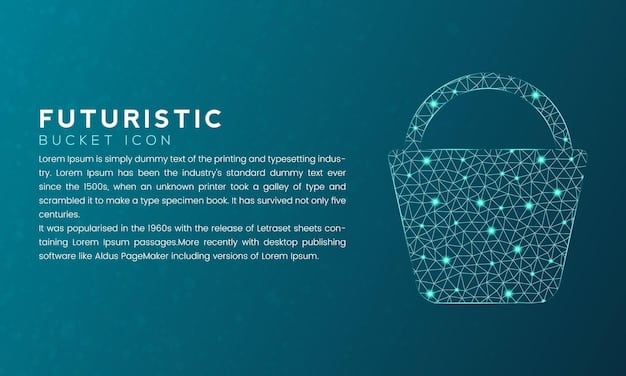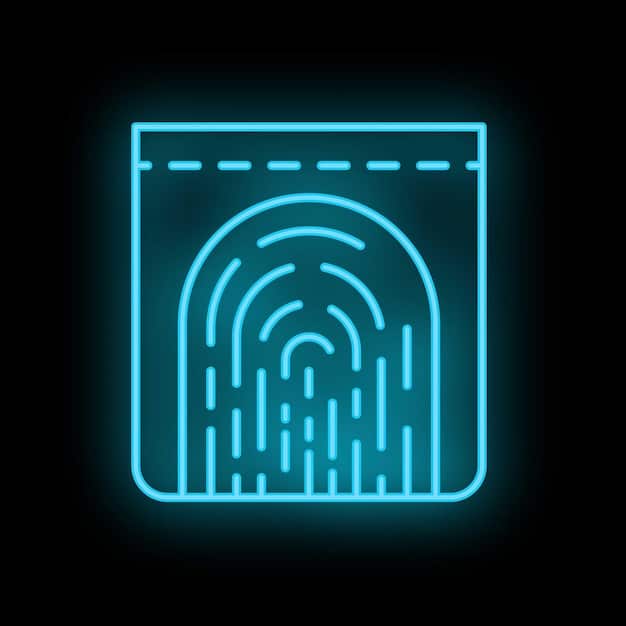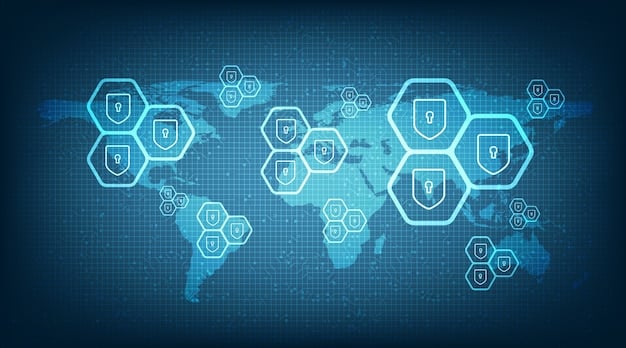E-commerce Website Security: Protecting Your Business and Customers

Robust e-commerce website security is crucial for safeguarding sensitive customer data and business operations against the ever-evolving landscape of cyber threats, ensuring trust and continuity in online transactions.
In the digital age, an e-commerce website is more than just a storefront; it’s a vault holding sensitive customer data and the very foundation of your business operations. Understanding e-commerce website security: protect your business and customers from cyber threats is no longer optional—it’s a critical imperative. This guide explores the multifaceted aspects of securing your online enterprise, from fundamental practices to advanced safeguards, ensuring both your assets and your customers’ trust remain intact.
the evolving landscape of e-commerce security threats
The digital realm is a constant battlefield, and e-commerce platforms are prime targets. Cybercriminals leverage sophisticated tactics, making it essential for businesses to stay ahead of vulnerabilities. Recognizing the nature of these threats is the first step in building a resilient security posture.
Online stores face a diverse array of risks, ranging from direct attacks on their infrastructure to subtle social engineering schemes targeting their customers. Staying informed about the latest threats and attack vectors is crucial for any business operating in the e-commerce space.
common cyber threats facing e-commerce
Modern cyber threats are complex and constantly evolving, requiring continuous vigilance. Understanding the most prevalent threats is essential for developing effective defense strategies.
- DDoS attacks: Distributed Denial of Service attacks overwhelm a server with traffic, causing the website to crash and become unavailable to legitimate users. This can lead to significant financial losses and reputational damage.
- Phishing and social engineering: Cybercriminals use deceptive emails or websites to trick customers or employees into revealing sensitive information, such as login credentials or financial details. These attacks often target human vulnerabilities.
- SQL injection: Attackers insert malicious SQL code into input fields to manipulate database queries, potentially gaining unauthorized access to sensitive data or altering website content.
- Cross-site scripting (XSS): Malicious scripts are injected into legitimate websites to steal user cookies, session tokens, or other sensitive information, often leading to identity theft or unauthorized account access.
Beyond these, newer threats like supply chain attacks on third-party integrations and sophisticated malware targeting payment systems are also on the rise. Businesses must not only defend against known threats but also anticipate emerging ones. The interconnected nature of e-commerce means a vulnerability in one component can compromise the entire chain.
The sheer volume of online transactions and the sensitive financial and personal data involved make e-commerce sites particularly attractive targets for malicious actors. Therefore, security measures must be comprehensive, layered, and continuously updated to counter new threats effectively.
In conclusion, the threat landscape for e-commerce is dynamic and relentless. A proactive and adaptive approach to security, including constant monitoring and threat intelligence, is paramount to protect both the business and its customers from economic and reputational damage.
foundational security measures for e-commerce websites
Building a secure e-commerce platform starts with establishing strong foundational measures. These are the bedrock upon which all other security layers are built, preventing the most common and pervasive attacks.
Implementing basic, yet robust, security protocols is the primary defense against many cyber threats. Without these fundamental safeguards, even advanced security solutions may prove insufficient. They ensure a minimum level of protection and compliance.
ssl/tls certificates: securing data in transit
An SSL/TLS certificate is non-negotiable for any e-commerce site. It encrypts the data exchanged between the customer’s browser and your server, protecting sensitive information like credit card details, login credentials, and personal data from eavesdropping.
- Encryption: Ensures that all data transmitted is scrambled, making it unreadable to unauthorized parties. This is essential for maintaining customer privacy.
- Authentication: Verifies the identity of your website, assuring customers that they are connecting to the legitimate site and not a fraudulent one.
- SEO benefits: Search engines like Google prioritize secure websites, giving those with SSL/TLS certificates a slight ranking boost.
Beyond the technical aspect, an SSL/TLS certificate builds trust. Customers are more likely to complete purchases on sites that display the padlock icon and “https://” in the URL, signaling a secure connection. This visual cue is a simple yet powerful psychological assurance for online shoppers.
robust payment processing security
Securing payment transactions is critical. Adhering to the Payment Card Industry Data Security Standard (PCI DSS) is not just a best practice; it’s often a regulatory requirement for businesses handling credit card information.
PCI DSS compliance involves a set of security standards designed to ensure that all companies that process, store, or transmit credit card information maintain a secure environment. This includes regular security testing, strict access controls, and data encryption. Using third-party payment gateways like Stripe or PayPal can significantly offload much of the PCI DSS burden, as these services specialize in secure payment processing.
However, even with third-party processors, businesses must ensure that their integration points are secure and that no sensitive card data touches their servers unnecessarily. Tokenization and end-to-end encryption are key concepts here. Tokenization replaces sensitive card data with a unique, non-sensitive identifier, making the actual card number useless if intercepted.
Ultimately, a strong payment security protocol protects not only your customers’ financial data but also your business from costly data breaches and compliance penalties. It also reinforces the brand’s commitment to customer safety.
strong authentication and access controls

Implementing strong authentication mechanisms and strict access controls is paramount for protecting administrative interfaces and sensitive customer accounts. This extends beyond basic passwords to include more sophisticated layers of protection.
Multi-factor authentication (MFA), such as requiring a password plus a code sent to a mobile device, significantly reduces the risk of unauthorized access. This adds a crucial layer of security, making it exponentially harder for attackers to compromise accounts even if they obtain a password.
For internal systems, the principle of least privilege should be applied, meaning employees only have access to the data and systems necessary to perform their job functions. Regular reviews of user permissions and prompt removal of access for former employees are also vital to minimize internal threats. Employee training on security best practices, including recognizing phishing attempts and using strong, unique passwords, complements these technical controls. These combined efforts create a more secure ecosystem for both internal operations and customer interactions.
By prioritizing these foundational security measures, e-commerce businesses can lay a solid groundwork for protecting their operations and their customers from a vast majority of cyber threats.
advanced security technologies and practices
While foundational security measures are crucial, the dynamic nature of cyber threats necessitates the adoption of advanced technologies and practices. These layers provide enhanced protection against sophisticated attacks and emerging vulnerabilities.
Moving beyond the basics involves leveraging tools and methodologies that offer real-time threat detection, automated responses, and continuous vulnerability assessment. This proactive approach is essential in today’s threat landscape.
web application firewalls (waf) and intrusion detection/prevention systems (idps)
A Web Application Firewall (WAF) acts as a shield between your e-commerce website and the internet, filtering out malicious traffic before it reaches your server. It protects against common web vulnerabilities like SQL injection, cross-site scripting (XSS), and DDoS attacks.
WAFs can analyze HTTP requests in real-time, blocking suspicious traffic based on predefined rules or behavioral analysis. Similarly, Intrusion Detection Systems (IDS) and Intrusion Prevention Systems (IPS) monitor network traffic for suspicious activity. IDSs alert administrators to potential threats, while IPSs can automatically block or contain them.
These systems are critical for detecting and mitigating threats that might bypass traditional perimeter defenses. They provide an extra layer of detection and response, ensuring that anomalies are quickly identified and addressed. Implementing a robust WAF and an effective IDPS significantly reduces the attack surface for e-commerce sites.
regular security audits and penetration testing
No system is perfectly secure indefinitely. Regular security audits and penetration testing are indispensable for identifying vulnerabilities before malicious actors can exploit them. These proactive assessments simulate real-world attacks to uncover weaknesses.
- Security audits: Comprehensive reviews of your security policies, configurations, and procedures to ensure compliance with best practices and industry standards like PCI DSS.
- Vulnerability scanning: Automated tools scan your systems and applications for known vulnerabilities, providing a fast and efficient way to identify common weaknesses.
- Penetration testing: Ethical hackers attempt to breach your systems using various attack methods, providing a realistic assessment of your defenses and highlighting exploitable flaws.
These tests should be conducted periodically, especially after significant system changes or before major promotional events. The insights gained from audits and penetration tests allow businesses to patch vulnerabilities, strengthen defenses, and continuously improve their security posture. This iterative process of testing, identifying, and remediating ensures ongoing resilience against evolving threats.
data encryption at rest and in transit
Beyond SSL/TLS for data in transit, sensitive data should also be encrypted at rest—meaning when it’s stored on your servers or databases. This includes customer personal information, payment details (if stored), and other confidential business data.
Encryption at rest adds another layer of protection, making data unreadable even if a database is breached. Strong encryption algorithms, coupled with secure key management practices, are essential. This ensures that unauthorized parties cannot access or decipher the data even if they manage to gain access to your storage systems.
Technologies like transparent data encryption (TDE) for databases and full disk encryption (FDE) for servers are examples of how data at rest can be protected. This comprehensive approach to encryption—both in transit and at rest—significantly enhances data privacy and reduces the impact of potential breaches.
By adopting these advanced security technologies and practices, e-commerce businesses can build a multi-layered defense system that is capable of thwarting even the most sophisticated cyber threats, thereby safeguarding their operations and customer trust.
customer data protection and privacy
In the age of data, protecting your customers’ personal information and ensuring their privacy is not just a matter of compliance but a cornerstone of trust. Businesses must prioritize robust data handling practices.
Beyond legal obligations, consumers are increasingly concerned about how their data is collected, stored, and used. Transparency and comprehensive protection are key to fostering long-term customer relationships.
data minimization and retention policies
A fundamental principle of data privacy is data minimization: collect only the data that is absolutely necessary for your business operations and nothing more. This reduces the risk exposure in case of a breach.
Equally important are data retention policies. Don’t keep customer data indefinitely. Establish clear guidelines for how long different types of data are stored and ensure that data is securely deleted when no longer needed. This practice reduces the volume of sensitive information that could potentially be compromised and aligns with privacy regulations.
Regularly auditing data collection points and storage locations helps ensure compliance with these policies. By adopting a “less is more” approach to data, businesses can significantly lower their risk profile and simplify their compliance efforts, demonstrating a commitment to customer privacy.
compliance with data privacy regulations
The global landscape of data privacy laws is complex and constantly evolving. E-commerce businesses, particularly those serving an international customer base, must navigate regulations such as GDPR (General Data Protection Regulation) for European customers and CCPA (California Consumer Privacy Act) for Californian residents, among others.

Compliance often requires implementing specific measures:
- Consent management: Obtaining explicit consent from customers before collecting and processing their data, especially for marketing purposes.
- Data access and deletion rights: Allowing customers to request access to their data or have it deleted upon request.
- Data breach notification: Having procedures in place to promptly notify affected customers and regulatory authorities in the event of a data breach.
Non-compliance can result in substantial fines and damage to reputation. It is advisable to consult with legal counsel to ensure full adherence to all relevant data privacy regulations for your target markets. Proactive compliance builds customer trust and avoids potential legal pitfalls.
secure data storage and access controls
Even with data minimization, the data you do collect must be stored securely. This involves a multi-pronged approach that goes beyond basic encryption.
Implementing stringent access controls ensures that only authorized personnel can view or modify sensitive customer data. This includes role-based access control (RBAC), where permissions are granted based on an employee’s role and responsibilities. Regular auditing of who accesses data and when can help detect suspicious internal activity.
Furthermore, data storage solutions should leverage the latest security features, including advanced encryption (as discussed previously), robust backup and recovery protocols, and physical security measures for on-premise servers. For cloud-based solutions, ensure your cloud provider adheres to the highest security standards and that your configurations are optimized for security. The goal is a “defense in depth” strategy, where multiple layers of security protect customer data irrespective of how it is accessed or stored.
By meticulously addressing data protection and privacy, e-commerce businesses not only comply with legal mandates but also build a bond of trust with their customers, which is invaluable in the competitive online marketplace.
operational security best practices
Beyond specific technologies, establishing robust operational security practices is integral to maintaining a strong defense posture. These are the routines and policies that dictate how security is managed on a daily basis.
Operational security is about the human element and continuous process improvement. It ensures that security considerations are embedded into every aspect of business operations, from development to customer service.
regular software and system updates
One of the most common vulnerabilities exploited by attackers stems from outdated software. All components of your e-commerce infrastructure—operating systems, content management systems (CMS), plugins, themes, and third-party integrations—must be kept up to date.
Developers frequently release patches and updates that fix security flaws. Neglecting these updates leaves your system exposed to known exploits. Automate updates where possible, but always test them in a staging environment first to prevent compatibility issues from disrupting your live site. This proactive approach significantly reduces the attack surface and fortifies your system against known threats.
employee security training and awareness
The human element often represents the weakest link in the security chain. Employees need to be adequately trained on security best practices and aware of common cyber threats like phishing, social engineering, and malware.
- Phishing awareness: Teach employees how to identify suspicious emails and attachments.
- Password hygiene: Emphasize the importance of strong, unique passwords for all accounts and the use of password managers.
- Data handling: Educate staff on proper procedures for handling sensitive customer data and reporting suspicious activity.
Regular training sessions, simulated phishing attacks, and clear security policies reinforce these lessons. Creating a security-conscious culture within your organization can dramatically reduce the risk of successful cyberattacks originating from human error or negligence.
incident response planning
Despite all preventive measures, a security incident or data breach is always a possibility. Having a well-defined incident response plan (IRP) is crucial for minimizing damage and ensuring a swift recovery.
An IRP outlines the steps to take before, during, and after a security incident. Key components include:
- Preparation: Identifying critical assets, establishing communication channels, and assigning roles and responsibilities.
- Detection and analysis: Monitoring for anomalies, confirming incidents, and assessing their scope and impact.
- Containment: Isolating affected systems to prevent further spread of the attack.
- Eradication: Removing the cause of the incident and restoring affected systems.
- Recovery: Bringing systems back online securely and validating their integrity.
- Post-incident review: Learning from the incident to improve future security measures.
Regularly testing your IRP through tabletop exercises or drills ensures that your team is prepared to act effectively when a real incident occurs. A quick and coordinated response can save significant reputational and financial costs, reinforcing customer trust even after a compromise.
Implementing these operational security best practices helps create a resilient and adaptive security framework, essential for protecting your e-commerce business and its valuable customer base in the long run.
building a culture of security and trust
Ultimately, e-commerce security is not just about technology; it’s about fostering a pervasive culture where security is everyone’s responsibility. This holistic approach builds enduring trust with customers.
Embedding security consciousness into the company’s DNA, from leadership to entry-level employees, creates a fortified and resilient operational environment. This cultural commitment extends beyond compliance to genuinely prioritize customer welfare.
transparency and communication with customers
In the event of a security incident, transparency with your customers is paramount. While it might be tempting to downplay or conceal a breach, a frank and honest approach builds long-term trust, even in adversity.
Communicate promptly and clearly about what happened, what data was affected, and what steps you are taking to mitigate the damage and prevent future occurrences. Provide resources for customers to protect themselves, such as advice on changing passwords or monitoring credit reports.
Proactive communication about your security measures and privacy policies also builds confidence. Share information about your SSL certificates, PCI DSS compliance, and data protection efforts through clear and accessible privacy policies. This openness fosters a sense of security and reliability among your customer base.
continuous monitoring and improvement
The cyber threat landscape is constantly evolving, meaning security is never a “set it and forget it” task. Continuous monitoring of your systems, networks, and applications is essential to detect suspicious activity in real-time.
Leverage security information and event management (SIEM) systems to aggregate and analyze security logs, identifying patterns that indicate potential threats. Implement user and entity behavior analytics (UEBA) to detect anomalous user activities.
Furthermore, regularly review your security posture, adapting to new threats and implementing emerging best practices. This iterative process of monitoring, assessing, and improving ensures that your e-commerce security remains robust and effective in the face of new challenges. Investing in advanced threat intelligence subscriptions can also provide timely insights into emerging vulnerabilities relevant to your industry.
leveraging third-party security expertise
For many e-commerce businesses, especially SMEs, developing in-house security expertise for every aspect of cybersecurity can be challenging. Partnering with specialized third-party security providers can fill these gaps effectively.
These experts can assist with:
- Managed security services: Outsourcing security monitoring, incident response, and threat detection.
- Security consulting: Gaining expert advice on security architecture, compliance, and best practices.
- Vulnerability management: Regular scanning and penetration testing services to identify and remediate flaws.
Leveraging external expertise allows your business to focus on its core operations while benefiting from specialized cybersecurity knowledge and cutting-edge tools. This collaborative approach enhances your overall security resilience and ensures that your e-commerce website remains a safe and trusted environment for both your business and its valued customers.
By fostering a strong security culture rooted in transparency, continuous improvement, and strategic partnerships, e-commerce businesses can not only protect their assets but also cultivate unshakeable customer trust, which is the ultimate currency in the digital economy.
| Key Point | Brief Description |
|---|---|
| 🔒 Data Encryption | Encrypts data both in transit (SSL/TLS) and at rest to protect sensitive information from unauthorized access. |
| 🛡️ WAF & IDPS | Web Application Firewalls and Intrusion Detection/Prevention Systems filter malicious traffic and detect threats in real-time. |
| 🔄 Regular Audits | Consistent security audits and penetration testing identify vulnerabilities proactively, keeping systems robust. |
| 📈 Continuous Improvement | Ongoing monitoring and adaptation to new threats, with a focus on employee training and incident response planning. |
frequently asked questions about e-commerce website security
▼
SSL/TLS certificates encrypt data exchanged between a customer’s browser and your server, protecting sensitive information like credit card details. This prevents eavesdropping, authenticates your website’s identity, and also provides a minor SEO ranking boost, enhancing trust and security for online transactions.
▼
PCI DSS (Payment Card Industry Data Security Standard) is a set of security standards for companies that handle credit card information. Compliance is crucial because it ensures secure processing, storage, and transmission of card data, minimizing the risk of breaches and avoiding severe penalties and reputational damage.
▼
MFA significantly enhances security by requiring users to provide two or more verification factors to gain access, not just a password. This makes it much harder for cybercriminals to compromise accounts, even if they obtain a user’s password, by adding an essential layer of protection for customer and administrative accounts.
▼
WAFs act as a protective barrier, filtering out malicious traffic before it reaches your e-commerce server. They defend against common web attacks like SQL injection and XSS by analyzing HTTP requests in real-time. This helps protect your site from vulnerabilities and unauthorized access attempts, crucial for maintaining operational integrity.
▼
Developing a strong security culture is paramount. This involves continuous employee training on cyber threats, transparent communication with customers about security measures, and a commitment to continuous monitoring and improvement of security practices. Human vigilance and robust policies are as vital as technological safeguards.
conclusion
In the fiercely competitive world of e-commerce, cultivating a robust security posture is not merely a technical checkbox but a foundational pillar for sustainable growth and long-term customer trust. From implementing strong SSL/TLS encryption and adhering to PCI DSS standards to leveraging advanced WAFs and conducting regular penetration tests, every layer of defense contributes to a resilient ecosystem. Beyond the technological safeguards, fostering a security-aware culture within your organization, providing continuous employee training, and developing a solid incident response plan are equally critical. Ultimately, transparent communication with customers and a commitment to continuous improvement in the face of evolving cyber threats will distinguish your brand. By prioritizing comprehensive e-commerce website security: protect your business and customers from cyber threats, you safeguard not just data, but also your reputation, ensuring a trusted and thriving online presence.





